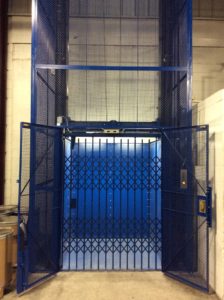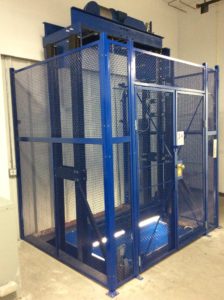For decades the Gillespie Corporation has manufactured both Vertical Reciprocating Conveyors (VRC’s) and freight elevators. VRC’s are excellent for moving material when riders are not required. The traditional solution for applications where riders are required is a freight elevator requiring a fully enclosed cab and an enclosed hoistway.
 However, Gillespie has recently developed a low-cost alternative to freight elevators that will allow riders. When Mobility Elevator contacted Gillespie looking for a material lift with limited pit depth that could be ridden by authorized personnel, a Type B Material Lift was proposed. This type of lift has its own section under A17.1 and allows riders.
However, Gillespie has recently developed a low-cost alternative to freight elevators that will allow riders. When Mobility Elevator contacted Gillespie looking for a material lift with limited pit depth that could be ridden by authorized personnel, a Type B Material Lift was proposed. This type of lift has its own section under A17.1 and allows riders.
The Challenge
Mobility Elevator’s customer, Spectrum Chemical, wanted a low-cost lift to move material that could also be ridden by factory personnel. Typically, this would be accomplished with a freight elevator which, due to elevator code requirements, would result in a substantive increase in equipment and hoistway construction costs.
Furthermore, because a standard pit could not be provided due to structural issues, a variance would have to be obtained. Gillespie has designed and manufactured numerous shallow pit freight and passenger elevators around the country, but Spectrum did not want to go to the expense of a full-blown freight elevator.
The Solution
Gillespie reviewed the constraints and determined that a lift could be designed which would meet the requirements of a Type B Material Lift per A17.1, Section 7.4. These requirements include a maximum speed of 30 feet per minute, access and usage restricted to authorized personnel and penetration of only one floor. Once it was confirmed that this lift would meet the proper prerequisites, the shallow pit (5 ¼”) became the next issue to be addressed.
As the A17.1 code permits the Type B Material Lift to accommodate shallow pits through the use of a non-removable safety device to satisfy the bottom car clearance requirement, a solution was readily available.
In addition, a Gillespie A17.1, Type B material lift, on the other hand, allowed costs to be reduced considerably on this project.
Design and Production
The lift provided has a 5’ 4” by 5’ 4” platform; the travel is 20’, and the capacity is 3,000 pounds with a speed of 30 fpm. The pit depth is 5 ¼”. The car is guided by two 15 lbs/ft t-rails which are connected to W-beams for stability. There is 13’-4 ½” of overhead and the car is lifted by an overhead drum machine with a 5.4 hp motor.
Due to the limited pit depth, non-removable safety devices were required to satisfy the bottom car clearance. When deployed, the safety devices stopped the car 60” above the pit floor.
Although it is not required per code, the customer requested that the lift be provided with a Gillespie c ollapsible car gate. All the structural steel on the lift was powder coated blue, as were both the upper and lower landing wire mesh enclosures supplied by WireCrafters.
ollapsible car gate. All the structural steel on the lift was powder coated blue, as were both the upper and lower landing wire mesh enclosures supplied by WireCrafters.
The lower landing enclosure is 19’ 3” high, while the upper landing enclosure is 8’ 5” high. Each enclosure has a 5′ 2” wide by 7’ 0” double swing gate so that larger materials can be loaded onto the platform by forklift. The gates are fitted with interlocks to ensure that they can only be opened at the floor the where the car stops.
The non-removable safety devices are mounted to the guide rails and are deployed and retracted by linear actuators. There are also two micro switches that monitor the position each safety device. One microswitch prevents the car from running unless the safety devices are fully retracted while the other micro switch prevents access to the shaftway unless the safety devices are fully deployed.
Control stations are located at the lower and upper landings and the lower landing control station also has a key switch to control the safety devices. Additionally, there is a car operating panel (COP) in the car for use by authorized personnel. The lift has upper and lower normal and final limit switches.
Operation
To operate the lift, it is first called to a specific landing. Once it reaches the landing, the retiring cam extends and releases the interlock so the wire mesh gate is unlocked. From here the lift can be loaded with material. The lift can then be either called or sent to the other landing. When the lift is called to another level the retiring cam retracts, locking the wire mesh gate and the lift begins traveling in the shaftway.
Conclusion
As demonstrated by the Spectrum project for Mobility Elevator, the Type B material lift designed and manufactured by Gillespie provides a practical, flexible and less expensive alternative to the traditional freight elevator.
Elevator Designer and Manufacturer: Gillespie Corporation
Installer: Mobility Elevator & Lift Company
Fixtures: Innovations Industries Inc.
Machine: SEW-Eurodrive
Wire Mesh Enclosure and Gates: WireCrafters